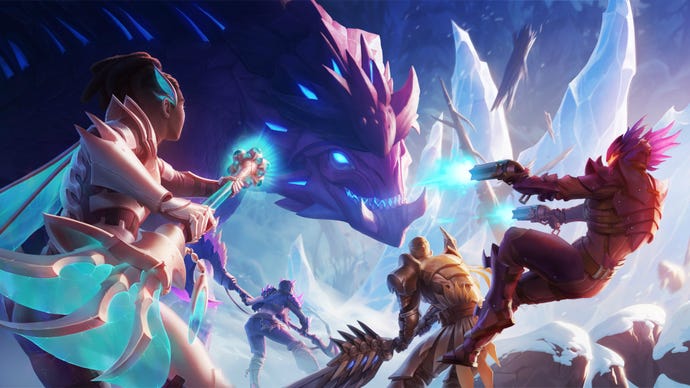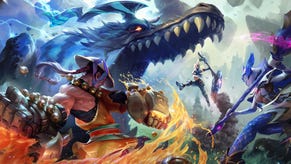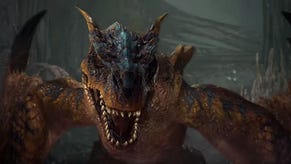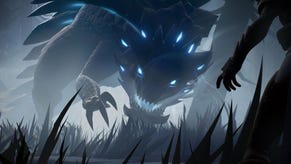Dauntless Review
Phoenix Labs stands undaunted in the face of Capcom's Monster Hunter: World.
This article first appeared on USgamer, a partner publication of VG247. Some content, such as this article, has been migrated to VG247 for posterity after USgamer's closure - but it has not been edited or further vetted by the VG247 team.
Dauntless is the Honda Civic of the monster hunting genre. It's not a top-of-the-line release, especially not compared to Capcom's Monster Hunter: World, which iterates on a classic franchise with big-budget premium polish. It's not quite God Eater 3 either, a game that leans on more aggressive play and an anime aesthetic. It's not as complex as one, or as stylish as the other, but despite that, it does seem to find its own spot in the genre.
Phoenix Labs is clearly working from Monster Hunter as an inspiration. Dauntless feels like Fortnite to Monster Hunter's PUBG; a little less complex or robust in terms of mechanics, with a hearty helping of current free-to-play concepts, like season passes. That streamlining makes an experience that's actually enticing if you enjoy the idea of Monster Hunter, but don't want to give yourself over to it completely.
Players journey out from the city of Ramsgate, a bit of civilization in a region of floating islands called the Shattered Isles. On each of these islands are Behemoths, giant monsters which you need to hunt for skins, horns, fangs, and more. The materials you gain from each hunt are used to craft new weapons and armor, which in turn make you better at subsequent missions . Dauntless breaks down into various Tiers, regions which contain certain groups of Behemoths: The Sheltered Frontier, The Monstrous Verge, The Yonder Keys, The Uncharted Reaches, and The Maelstrom.
Behemoths themselves also break down into various elemental classes, including Blaze, Frost, Shock, or Umbral. You kill one, and craft gear that gives you a leg up on its fellow Behemoths. Blaze weapons do more damage against Frost Behemoths, while Blaze armor provides resistance against fire attacks. Once you've crafted all of the gear from a specific Behemoth, further hunting is required to upgrade it. Oddly enough, while more difficult Behemoths of the same elemental class provide different gear, that gear isn't necessarily stronger. The Thundering Blade crafted from the entry-level Drask Behemoth isn't more powerful than the Storm Sword from the Tier 4 Stormclaw, it just provides different perks.
Early on, Dauntless feels almost too simplistic compared to Monster Hunter: World. The fights for the lesser Behemoths in the first tier are really just training wheels. It's only around the third tier of fights, which includes the molten lava-spitting Charogg, that you'll need to start learning Dauntless' deeper mechanics.
In Dauntless, you're working with a total of six weapon types: Sword, Hammer, Axe, War Pike, Chain Blades, and the pistol-like Repeaters. Sword is the jack-of-all-trades, not too fast, but holding decent power. Each weapon is pretty easy to pick up, but all of them have specific combos and unique traits to drag out their best potential. The Repeaters for example, are actually close-range weapons, doing the most damage somewhere in melee range and gaining additional power by reloading close to the target.

There are deeper mechanics beyond that as well. The War Pike is better at wounding Behemoths, which applies a damage debuff to them. There's also staggering-referred to as "booping" by the Dauntless community-which uses specific weapon attacks against certain behemoth pattern to daze them for free hits. You can survive without understanding these concepts early on, but at a certain point in progression, you'll make things much harder for yourself and your team.
Part of my major appreciation for Dauntless is a matter of time. Monster Hunter: World hunts are much longer affairs, taking 30-45 minutes even for relatively low-level monsters. Even then, multiplayer grouping and matchmaking is cumbersome in MHW. Dauntless matchmaking is painless and straightforward, and if your hunt goes above 20 minutes, you're either undergeared or not approaching the fight correctly. Hell, there's a soft time limit for each hunt and a visible enrage timer, which rises as you fight a behemoth. Once the Danger meter is full, the Behemoths are hit much harder and party reviving no longer works. Everything is focused on a quicker experience, without completely losing the combat depth. This means it's easy to jump in for one quick hunt in the middle of my day.
The other amazing thing is Dauntless is 100 percent cross-platform and cross-play. Whether you're on PC, PlayStation 4, or Xbox One, you enjoy the same experience, and you can hunt with players on any platform. In an industry where cross-play isn't normal and it's frequently impossible to move your progress from platform to platform, Dauntless is a clear winner.
There are less successful aspects though. There's the general issue of bugs, like becoming stuck in a menu if you open it while leaving a hunt. Some players are also reporting falling through the landscape in certain spots of the map. I've personally found that collecting certain materials like herbs or ore on a hunt doesn't always work.

The city of Ramsgate and many of the Shattered Isles feel decidedly "gamey" too. Monster Hunter: World did an excellent job of making the hub area and hunting environments feel like real locations. There's a generally lack of life in Dauntless' Ramsgate, with only the primary shop NPCs doing anything. And the islands themselves feel rather small, given over to a small amount of exploratory space, but most decent-sized open arenas to fight Behemoths within.
Finally, Dauntless is free-to-play, with everything that entails. It basically copies Fortnite's seasonal Battle Pass wholesale with its own Hunt Pass. The basic track of progression each season will reward you with platinum currency or players banners, but the real unlockable cosmetics are only available through the paid Elite Hunt Pass. There's a ton of customization, from dyes to transmogrifying your gear, but most of the dyes and transmog stones require real-money microtransactions. If you want to look fly, you'll probably be spending a little money, which will probably irk and anger some folks. In practice though, I can see myself just avoiding purchasing future Hunt Passes.
In the middle of playing another game for review—the treadmill never stops—I started and completed my first hunt against insectoid Kharabak. It's my first time using the War Pike, which is the recommended weapon for taking parts off each of the Behemoths. I'm learning the fight, and the weapon at the same time. It's not going well, as my team is roughly in the same spot as myself in terms of encounter knowledge. Kharabak begins to glow with increased power, and rears up to charge at us. I engage the War Pike's secondary fire, which charges to shoot a projectile at your target. BAM, I hit Kharabak as it begins to charge at me, sending it tumbling and dazed. And while it's stumbling around, we finish it off.
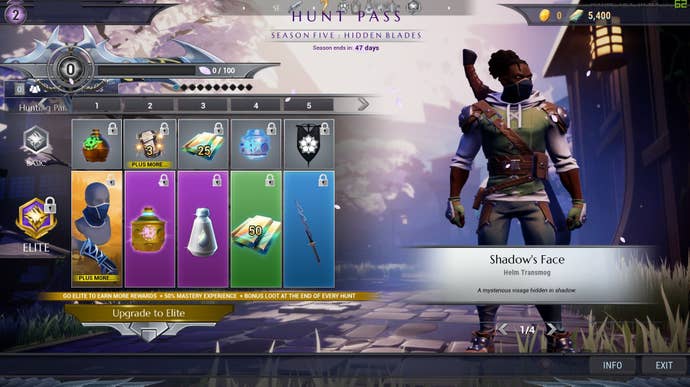
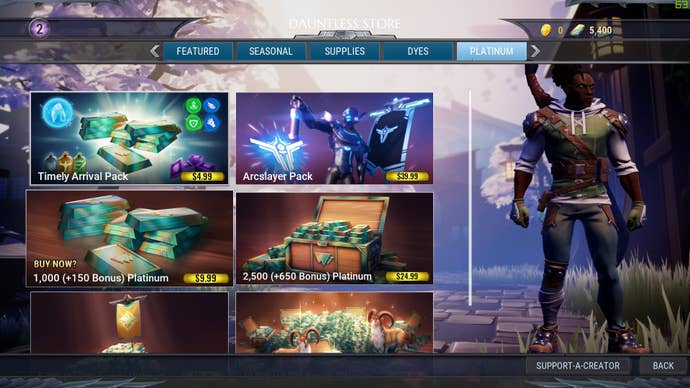
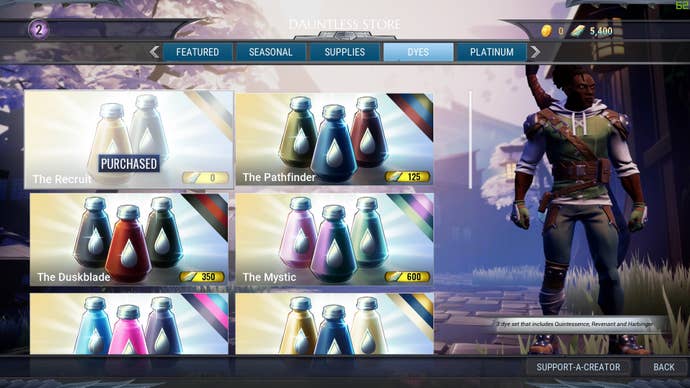
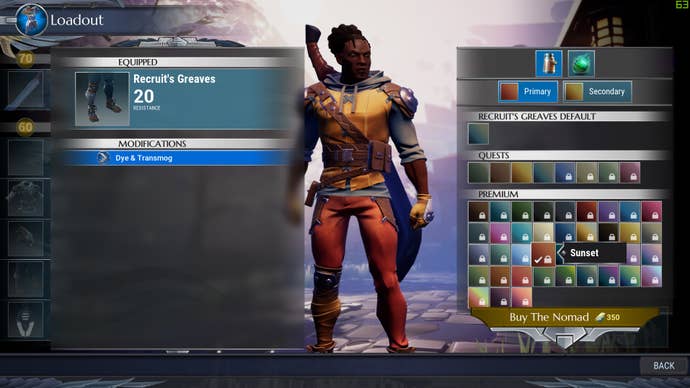
Those are the best moments of games like Dauntless and Monster Hunter, and the road to get these moments is much shorter in the former. I don't necessarily want to be as deep into that experience as Monster Hunter: World requires. And since Dauntless is free, it's easy for everyone to try, meaning the community is a strong one. It's fun, and it doesn't get in its own way too much, which is enough for me to recommend it.
ConclusionDauntless is Monster Hunter for those that don't have the time or money to devote to Capcom's Monster Hunter: World. Dauntless falters in certain areas, but provides the feel of hunting and gear progression in a more streamlined manner. the world can feel a bit lifeless and gamey at times, but this is definitely good enough to carve out its own space alongside Capcom's flagship series. And being free-to-play with full cross-platform play helps a great deal.
